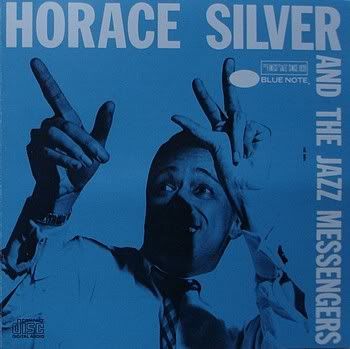
Horace Silver - Horace Silver & The Jazz Messengers - 1956 - Blue Note Records (USA)
A true classic, this CD found pianist Horace Silver and drummer Art Blakey co-leading the Jazz Messengers; Silver would leave a year later to form his own group. Also featuring trumpeter Kenny Dorham, Hank Mobley on tenor, and bassist Doug Watkins, this set is most notable for the original versions of Silver's "The Preacher" and "Doodlin'," funky standards that helped launch hard bop and both the Jazz Messengers and Silver's quintet. Essential music. © Scott Yanow, All Music Guide
You should buy Horace Silver's magnificent 1964 "Song for My Father" album.
TRACKS
1. Room 608, (Horace Silver) 5:19
2. Creepin' In, (Horace Silver) 7:25
3. Stop Time, (Horace Silver) 4:05
4. To Whom It May Concern, (Horace Silver) 5:07
5. Hippy, (Horace Silver) 5:20
6. The Preacher, (Horace Silver) 4:15
7. Hankerin', (Hank Mobley) 5:15
8. Doodlin', (Horace Silver) 6:44
[1-3,8] Recorded on December 13, 1954, at the Van Gelder Studio, Hackensack, New Jersey
[4-7] Recorded on February 6, 1955, at the Van Gelder Studio, Hackensack, New Jersey
Produced by Alfred Lion
Cover Photo by Francis Wolff
Cover Design by Reid Miles
Recording by Rudy Van Gelder
MUSICIANS
Horace Silver (piano)
Hank Mobley (tenor saxophone)
Kenny Dorham (trumpet)
Doug Watkins (double bass)
Art Blakey (drums)

Horace Silver
REVIEWS
In 1954, pianist Horace Silver teamed with drummer Art Blakey to form a cooperative ensemble that would combine the dexterity and power of bebop with the mid-tempo, down-home grooves of blues and gospel music. The results are what would become known as hard bop, and the Jazz Messengers were one of the leading exponents of this significant era in jazz history. Before Silver's departure and Blakey's lifetime of leadership, this first major session by the original Jazz Messengers set the standard by which future incarnations of the group would be measured. The tunes here are all Silver's, save the bopping "Hankerin'" by tenor man Hank Mobley. Such cuts as the opening "Room 608," the bluesy "Creepin' In," and "Hippy" are excellent examples of both Silver's creative composing style and the Messengers' signature sound. Of course, the most remembered tunes from the session are the classic "The Preacher" and "Doodlin'," two quintessential hard bop standards. In all, this set is not only a stunning snapshot of one of the first groups of its kind but the very definition of a style that dominated jazz in the '50s and '60s and enjoyed a resurgence in the '80s. © 1996 - 2008 CD Universe
Late in 1954 a quartet under the leadership of Horace Silver was playing at Minton's Playhouse. As a result of earlier successes on the Blue Note label, Horace's star was in the ascendancy and Alfred Lion was anxious to record more of his brilliant hard driving piano. It was decided that this date would present Horace as a combo leader for the first time. He responded by getting Kenny Dorham and Art Blakey to join himself and two of the members of his Minton's quartet, Hank Mobley and Doug Watkins. Thus the Messengers were born, or reborn. Actually the name had been used before by Art Blakey when he led a 17-piece band on occasional gigs, and a septet on Blue Note, both in the late Forties. The present Messengers have laid permanent claim to the name by their length of existence and their musical excellence. In most informed, aware jazz circles they are considered to be the most muscular, spiritually rewarding group to come along in the past two years. Proceedings start with a fast unison theme, "Room 608" named for Horace's hotel room (Horace is hewing to the correct jazz line here, for hotel rooms have made jazz tune titles ever since Benny Goodman cut "Room 1411" in 1928). The ensemble is followed by two choruses of trumpet that will serve to convince you of Kenny Dorham's true ability. Seldom has he played with such fluency and assurance, in a style that seems to blend the best elements of both Gillespie and Davis. After two typically well-constructed choruses by Horace there is a series of cute unison breaks and piano fill-ins before Mobley takes over for a swinging solo. A rousing drum chorus precedes the return to the theme. "Creepin' In" sets a wonderful minor mood--slow, slinky and funky. It is better listened to than described. Listen to it. "Stop Time" contains only 16 bars of fast unison theme and gives everybody a chance to accomplish what seems to me to be their best work on the entire session: Dorham, Mobley, Silver and Blakey all sit in the spotlight successively and successfully. The open letter, "To Whom It May Concern," has scriveners Silver, Mobley, and Dorham spreading the word to one and all on the merits of getting to the heart of the matter and what it is all about. Once when Horace was being interviewed in reference to the group he said, "We can reach way back and get hat old time gutbucket barroom feeling with just a taste of the backbeat." He was referring of course, to "The Preacher," an earthy swinger somewhat reminiscent of "I've Been Working On The Railroad" in its melody line. In keeping with the title, everyone "preaches" in their solos. First Kenny exhorts and then Hank follows with a bluesy sermon. Rev. Silver gives the benediction and the congregation answers him. Hank Mobley shines on his original "Hankerin'" with a pace-setting opening solo that Kenny picks up beautifully before handing it over to Horace to expound on. Art has a characteristically telling solo before the close. "Doodlin'" is a 12-bar blues in which the tenor creeps below the trumpet at whole-tone intervals in the first 8 bars. Note too, the humorous use of staccato notes in bars 8 and 9. Note more particularly Horace's superb comping behind the Dorham and Mobley solos, in which he sometimes gets a 12-to-the-bar feel. This record proves again that the strength of jazz recording lies with the honest independents who are always the first to recognize and record real talent. © IRA GITLER, from the liner notes





1 comment:
LINK
Post a Comment